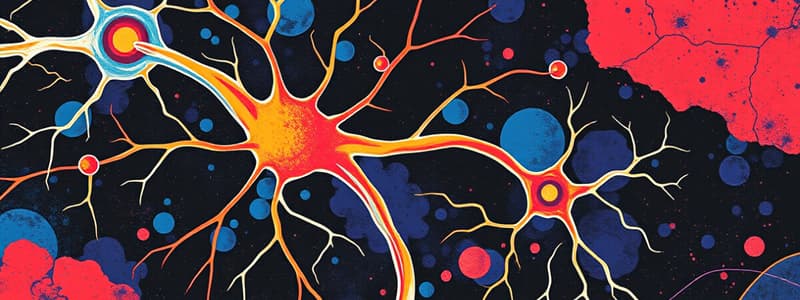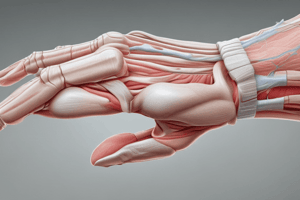Podcast
Questions and Answers
What is the function of the flexor reflex?
What is the function of the flexor reflex?
In both UE and LE, it causes movement of the flexor muscles to move a limb away from a harmful stimulus. In the LEs, it is also used for locomotion.
The flexor reflex is initiated by which type of receptors?
The flexor reflex is initiated by which type of receptors?
Cutaneous
Where are cutaneous receptors located?
Where are cutaneous receptors located?
In the skin; they respond to touch, pressure, pain, and temperature.
The flexor reflex arc is:
The flexor reflex arc is:
What is the flexor reflex receptor organ?
What is the flexor reflex receptor organ?
The afferent neuron of the flexor reflex arc is in what group?
The afferent neuron of the flexor reflex arc is in what group?
In the flexor reflex arc, the interneuron is:
In the flexor reflex arc, the interneuron is:
What type of neuron is the effector (efferent) neuron in the flexor reflex arc?
What type of neuron is the effector (efferent) neuron in the flexor reflex arc?
List the five components of the flexor reflex arc.
List the five components of the flexor reflex arc.
Describe the mechanism of the Flexor Reflex Afferents (FRA).
Describe the mechanism of the Flexor Reflex Afferents (FRA).
Interneurons are also known as what?
Interneurons are also known as what?
What is the purpose of FRA collaterals that synapse on various interneurons in the spinal cord?
What is the purpose of FRA collaterals that synapse on various interneurons in the spinal cord?
Describe the purpose of various interneurons for reciprocal innervation in the flexor reflex.
Describe the purpose of various interneurons for reciprocal innervation in the flexor reflex.
Interneurons for the reflex arc and reciprocal innervation synapse with cell bodies of motor neurons in which part of the spinal cord?
Interneurons for the reflex arc and reciprocal innervation synapse with cell bodies of motor neurons in which part of the spinal cord?
What is the function of alpha motor neurons?
What is the function of alpha motor neurons?
What motor response do alpha motor neurons cause in the flexor reflex?
What motor response do alpha motor neurons cause in the flexor reflex?
When does flexor withdrawal in the LE occur?
When does flexor withdrawal in the LE occur?
Describe reciprocal innervation in the flexor withdrawal of the LE.
Describe reciprocal innervation in the flexor withdrawal of the LE.
Every movement has reciprocal innervation.
Every movement has reciprocal innervation.
What is the crossed extension (extensor) reflex in the LE?
What is the crossed extension (extensor) reflex in the LE?
Describe reciprocal innervation in the crossed extension reflex of the LE.
Describe reciprocal innervation in the crossed extension reflex of the LE.
What type of interneuron is required for the movement of the contralateral leg in the crossed extension reflex?
What type of interneuron is required for the movement of the contralateral leg in the crossed extension reflex?
What is locomotion?
What is locomotion?
How does locomotion relate to the flexor reflex?
How does locomotion relate to the flexor reflex?
What two principles are involved with locomotion (and flexor reflex)?
What two principles are involved with locomotion (and flexor reflex)?
How are intersegmental interneurons involved with locomotion?
How are intersegmental interneurons involved with locomotion?
How does the cerebrum influence spinal reflexes during locomotion?
How does the cerebrum influence spinal reflexes during locomotion?
Role of reciprocal innervation for locomotion?
Role of reciprocal innervation for locomotion?
Flexor withdrawal in UE - typical chain of neural events?
Flexor withdrawal in UE - typical chain of neural events?
Reciprocal innervation of UE in flexor reflex?
Reciprocal innervation of UE in flexor reflex?
What happens during flexor reflex in the UE when there is a stronger stimulus?
What happens during flexor reflex in the UE when there is a stronger stimulus?
Describe associated reaction (UE).
Describe associated reaction (UE).
Describe crossed extension (UE).
Describe crossed extension (UE).
Describe the effects of the associated reaction and crossed extension during flexor withdrawal of the UE.
Describe the effects of the associated reaction and crossed extension during flexor withdrawal of the UE.
Describe the mechanisms of Associated Reactions.
Describe the mechanisms of Associated Reactions.
Describe the mechanisms of Crossed Extension during flexor reflex of UE.
Describe the mechanisms of Crossed Extension during flexor reflex of UE.
Describe how the ipsilateral leg is flexed via reciprocal innervation.
Describe how the ipsilateral leg is flexed via reciprocal innervation.
Describe how the contralateral leg is flexed via reciprocal innervation.
Describe how the contralateral leg is flexed via reciprocal innervation.
Which of the following are proprioceptive reflexes? (Select all that apply): a) Flexor reflex, b) Stretch reflex, c) GTO reflex.
Which of the following are proprioceptive reflexes? (Select all that apply): a) Flexor reflex, b) Stretch reflex, c) GTO reflex.
What are the structures responsible for initiating the stretch reflex and the GTO reflex?
What are the structures responsible for initiating the stretch reflex and the GTO reflex?
Flashcards are hidden until you start studying
Study Notes
Function of the Flexor Reflex
- Facilitates movement of flexor muscles to withdraw a limb from harmful stimuli.
- In lower extremities (LE), assists in locomotion.
Receptor Types
- Initiated by cutaneous receptors found in the skin.
- Respond to touch, pressure, pain, and temperature.
Structure of the Reflex Arc
- Flexor reflex arc is multi-synaptic.
- Includes cutaneous receptors as the receptor organ.
- Afferent neurons classified as Group II (touch, pressure) or Group III (pain, temperature).
- Interneurons are excitatory, while afferent fibers synapse on them.
Neuron Types
- Alpha motor neurons act as effector (efferent) neurons, synapsing on flexor muscles to generate movement.
- The flexor reflex arc consists of three neurons: afferents, interneurons, and motor neurons.
Mechanism of Flexor Reflex Afferents (FRA)
- FRA fibers are stimulated by cutaneous sensations.
- Action potentials travel to the spinal cord, synapsing on excitatory interneurons, which in turn synapse on alpha motor neurons.
- Axon collaterals extend to higher centers and additional interneurons for reflexive movement coordination.
Function of Interneurons
- Interneurons facilitate reciprocal innervation during the reflex: excitatory for flexors and inhibitory for extensors.
- Located in the ventral horn of the spinal cord for motor neuron synapses.
Response Types
- Alpha motor neurons produce flexor withdrawal (movement away from stimuli) in both upper extremities (UE) and lower extremities.
- In the LE, this is notably activated when stepping on sharp objects.
Crossed Extension Reflex
- Occurs in the contralateral leg during LE flexor withdrawal to maintain balance by extending the opposite limb.
- Involves reciprocal innervation: ipsilateral leg flexors activated while extensors inhibited; contralateral leg extensors activated while flexors inhibited.
Locomotion and Reflex Coordination
- Involves flexor withdrawal and crossed extension reflexes for coordinated movement during walking or running.
- Intersegmental interneurons ensure smooth coordination between upper and lower body movements.
Cerebrum's Influence on Reflexes
- Changes gait patterns based on terrain through descending tracts affecting spinal reflex responses.
Reciprocal Innervation Role
- Ensures efficient and coordinated movement patterns during activities like running, facilitating flexor activation and extensor inhibition.
Specifics of Upper Extremity Flexor Reflex
- Strong stimuli can lead to associated reactions affecting the contralateral limb and crossed extension affecting the lower limbs.
- Flexor muscles (e.g., brachialis and biceps) are excited, while extensor muscles (e.g., triceps) are inhibited during reflex actions.
Mechanisms of Associated Reactions and Crossed Extension
- Associated reactions involve bilateral flexor withdrawal due to excitatory and inhibitory commissural interneurons.
- Crossed extension involves shifting weight and activating or inhibiting motor neurons in an intersegmentally coordinated manner across the body.
Proprioceptive Reflexes
- Stretch reflex and Golgi tendon organ (GTO) reflex are considered proprioceptive reflexes, while the flexor reflex is classified as a cutaneous reflex.
Studying That Suits You
Use AI to generate personalized quizzes and flashcards to suit your learning preferences.




